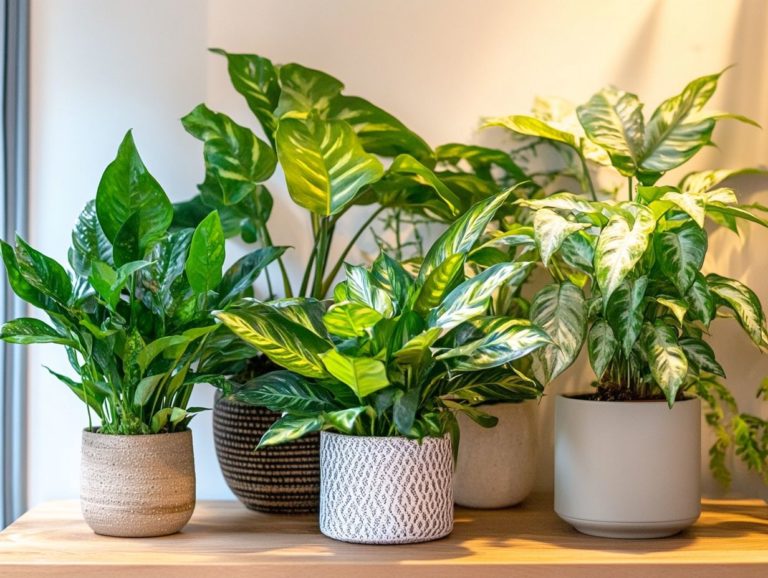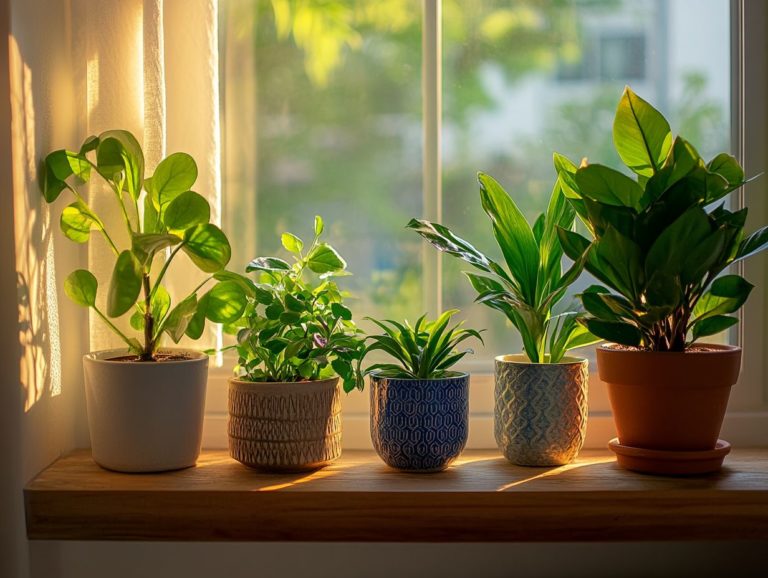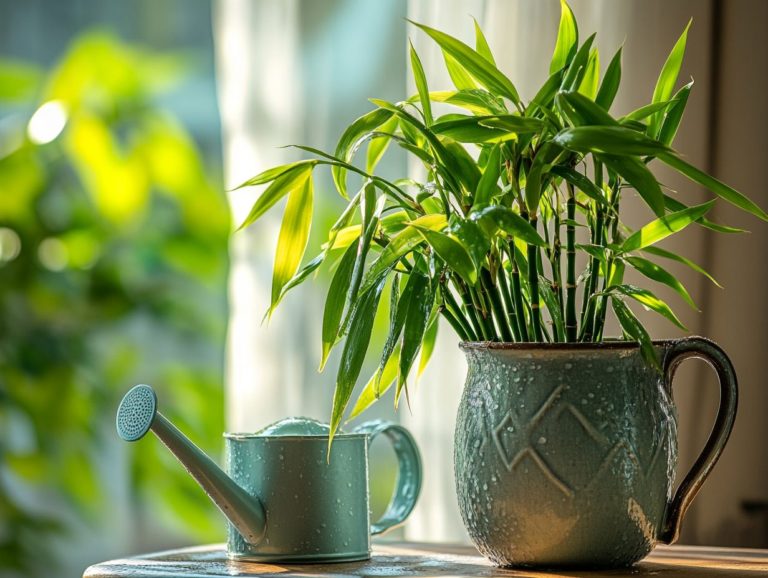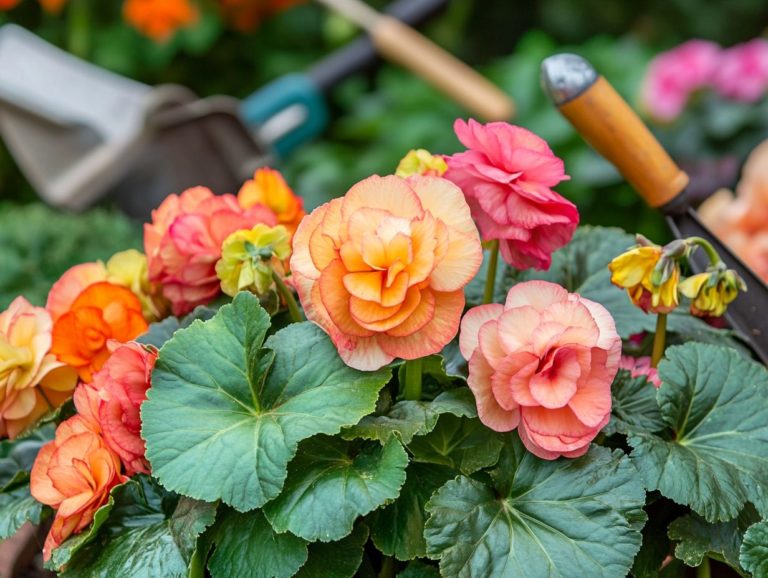How to Care for Indoor Chrysanthemums
Indoor chrysanthemums are colorful flowers that can truly elevate any space, but they do require a touch of care to thrive.
Let s dive into how you can select the right variety. You ll also need to grasp their specific needs for watering and sunlight, as well as master essential fertilizing and pruning techniques.
We ll explore identifying and treating common pests and diseases. Plus, we ll share best practices for repotting and offer tips to extend their blooming season.
Whether you re a seasoned plant enthusiast or just beginning your journey, you ll find everything you need to keep your indoor chrysanthemums flourishing beautifully.
Contents
Key Takeaways:

- Select the right chrysanthemum based on size, light, and bloom time.
- Keep your plants healthy with proper watering and sunlight.
- Learn how to prevent pests and extend blooming with easy tips.
What are Indoor Chrysanthemums?
Indoor chrysanthemums, affectionately known as mums, are colorful flowers you ll appreciate for their versatility and stunning array of colors. These potted beauties aren t just a feast for the eyes; they also provide a fantastic opportunity for indoor gardening, bringing a delightful burst of life to any living space.
Originating from Eastern Europe and Asia, chrysanthemums have captured the hearts of houseplant enthusiasts across the US and UK. You must understand their unique needs regarding light exposure, regular watering, and proper soil drainage to ensure their health and longevity, especially when growing chrysanthemums indoors.
To create ideal growing conditions, aim for bright, indirect sunlight and a comfortable temperature range of 65 to 70 degrees Fahrenheit. Don t forget that indoor chrysanthemums thrive on adequate humidity; dry air can stress them out and hinder their growth.
The vibrant blooms carry rich meanings across various cultures yellow signifies joy and optimism, while white embodies purity and truth. Be mindful of environmental shock, which can arise from sudden temperature shifts or improper watering, leading to wilting or premature flower drop.
With thoughtful care, such as deadheading blooms and maintaining humidity levels, your beautiful indoor oasis awaits!
Pick the Perfect Chrysanthemum for Your Home
Choosing the perfect chrysanthemum or indoor mums for your indoor gardening endeavor can significantly influence the outcome of your flowering journey.
With a diverse array of plant species at your disposal, it’s essential to take into account factors such as flower colors, the flowering cycle, and seasonal blooms. By doing so, you can create an environment where your indoor mums truly flourish.
Factors to Consider
When selecting the ideal chrysanthemum variety, you’ll want to consider several essential factors, such as light exposure, soil drainage, and the right amount of moisture in the air necessary for optimal growth. A solid understanding of plant temperature and the importance of regular watering can elevate your indoor gardening experience and ensure the vitality of your potted mums.
Light exposure plays a crucial role, as these vibrant flowers flourish in bright, indirect sunlight. This allows them to develop strong stems and lush foliage, encouraging abundant blooms.
Soil drainage is equally important; without it, the risk of root rot a condition caused by too much water that can damage roots becomes a significant concern, which can set back their health dramatically. It s essential to choose a pot with adequate drainage holes and use a well-aerated potting mix.
Maintaining the appropriate humidity levels in your indoor environment ideally between 40-60% is vital to prevent mildew and enhance the flowering process. Each of these aspects contributes significantly to creating the perfect habitat for a stunning display of chrysanthemums.
Proper Care for Indoor Chrysanthemums
Caring for indoor chrysanthemums requires a thoughtful approach. You should understand how often to water and provide the ideal light conditions to promote beautiful blooms.
As you engage in your indoor gardening routine, cultivate a nurturing environment for your seasonal blooms. This ensures they reach their full potential throughout their flowering cycle.
Watering and Sunlight Needs
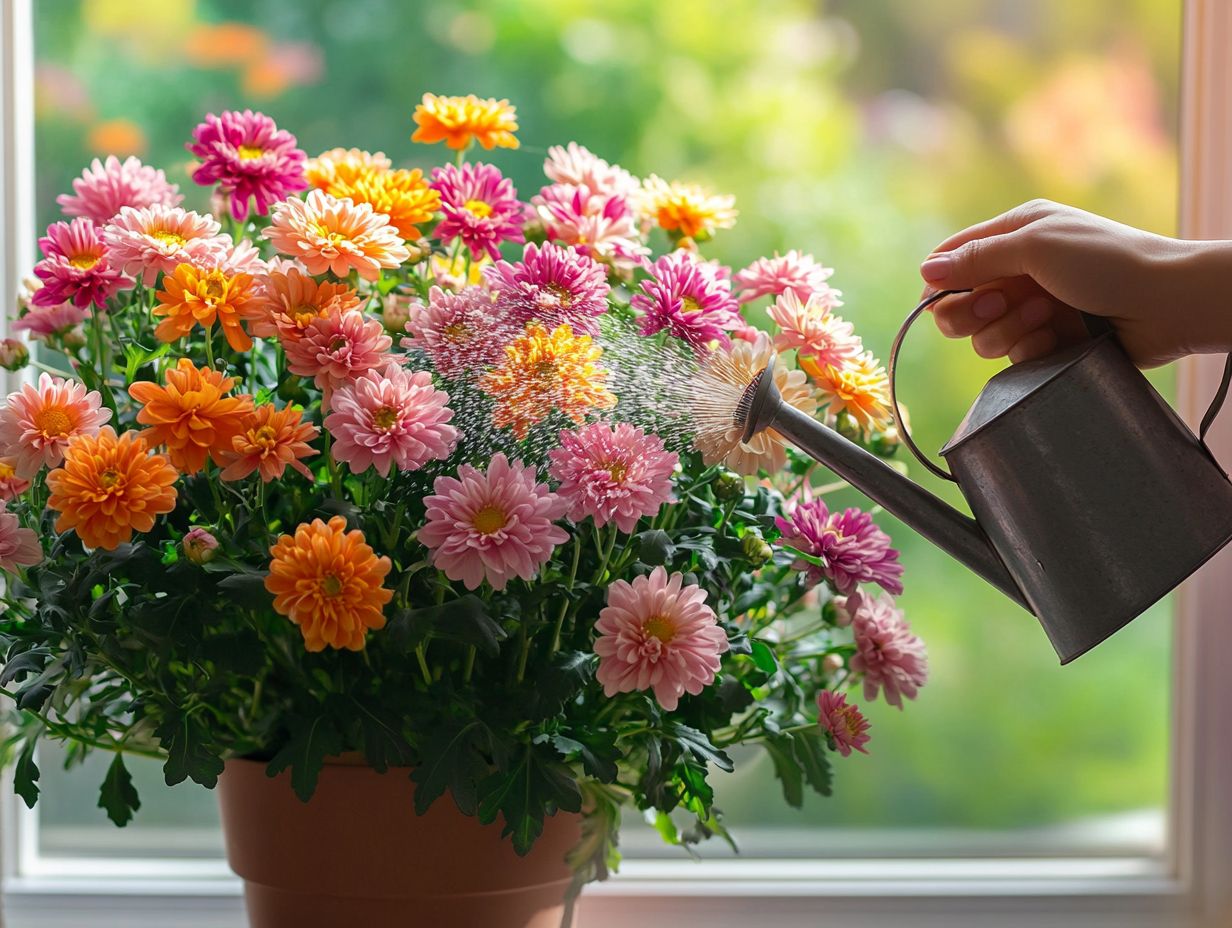
Watering and sunlight are essential for your indoor chrysanthemums. Finding the right balance is key to achieving vibrant blooms and robust growth. Keep an eye on your watering frequency to prevent over-watering or under-watering.
Give your plants the light they crave to bloom beautifully! Ideally, provide indirect sunlight, which promotes healthy development.
To pinpoint the optimal watering schedule, perform a finger test: stick your finger into the soil and check for moisture. Don t wait if the top inch feels dry, your plants need water now!
Over time, you ll learn the unique water requirements of your chrysanthemums. Adjust your watering routine according to seasonal changes and your indoor climate.
Understanding the difference between direct and indirect light is crucial. Direct sunlight can scorch leaves, while indirect light encourages growth without causing harm. These elements work together harmoniously, enhancing the overall health and vitality of your chrysanthemums, resulting in lush foliage and breathtaking flowers.
Fertilizing and Pruning Techniques
To boost the growth and flowering of your indoor chrysanthemums, mastering fertilizing and pruning is essential. Regularly provide your plants with the right nutrients and remove wilted flowers to extend their indoor flowering. Cutting propagation taking cuttings from a healthy plant to grow new ones is a savvy way to expand your collection of indoor mums.
Understanding the specific nutritional requirements at different growth stages is key to achieving vibrant results. For example, during the vegetative phase, a balanced fertilizer with a nitrogen boost promotes lush, green foliage. When it s time to bloom, use a phosphorus-heavy formula to encourage striking flowers.
Once flowering peaks, employ effective pruning techniques. Cutting back stems promotes branching and enhances the plant s shape and future blooms. Cutting propagation fosters healthy plants, as new stems take root effortlessly with proper care.
Common Pests and Diseases
Being aware of common pests and diseases is crucial for preserving the health of your indoor chrysanthemums. These threats can significantly undermine their vitality.
Regularly inspect your plants for common pests, and recognize signs of fungal issues, such as botrytis and leaf-spot disease. This knowledge empowers you to manage these challenges effectively and prevent complications.
Identifying and Treating Issues
Identifying and addressing issues like root rot, powdery mildew, and common pests is crucial for your indoor chrysanthemums, especially when they re affected by environmental shocks from temperature fluctuations.
Watch for symptoms like wilting leaves, yellowing foliage, or a pesky powdery white coating. Regular soil inspections for moisture levels and ensuring proper drainage are essential preventive measures.
Implement best practices such as:
- Adjusting your watering schedules
- Maintaining optimal humidity levels
- Utilizing organic fungicides
These steps can significantly reduce risks. Embrace integrated pest management techniques like introducing beneficial insects and rotating your plants to create a healthier environment for your chrysanthemums.
With attentive care, you can cultivate vibrant and resilient potted mums that truly thrive.
Repotting Your Chrysanthemums Made Easy
Repotting and transplanting are essential practices for maintaining the vibrant health of your indoor chrysanthemums. These practices are especially important when your plants become root-bound or pot-bound, which can cause stress from moving.
By using effective repotting techniques, you can significantly reduce transplant shock and ensure your plants thrive in ideal houseplant soil.
When and How to Repot
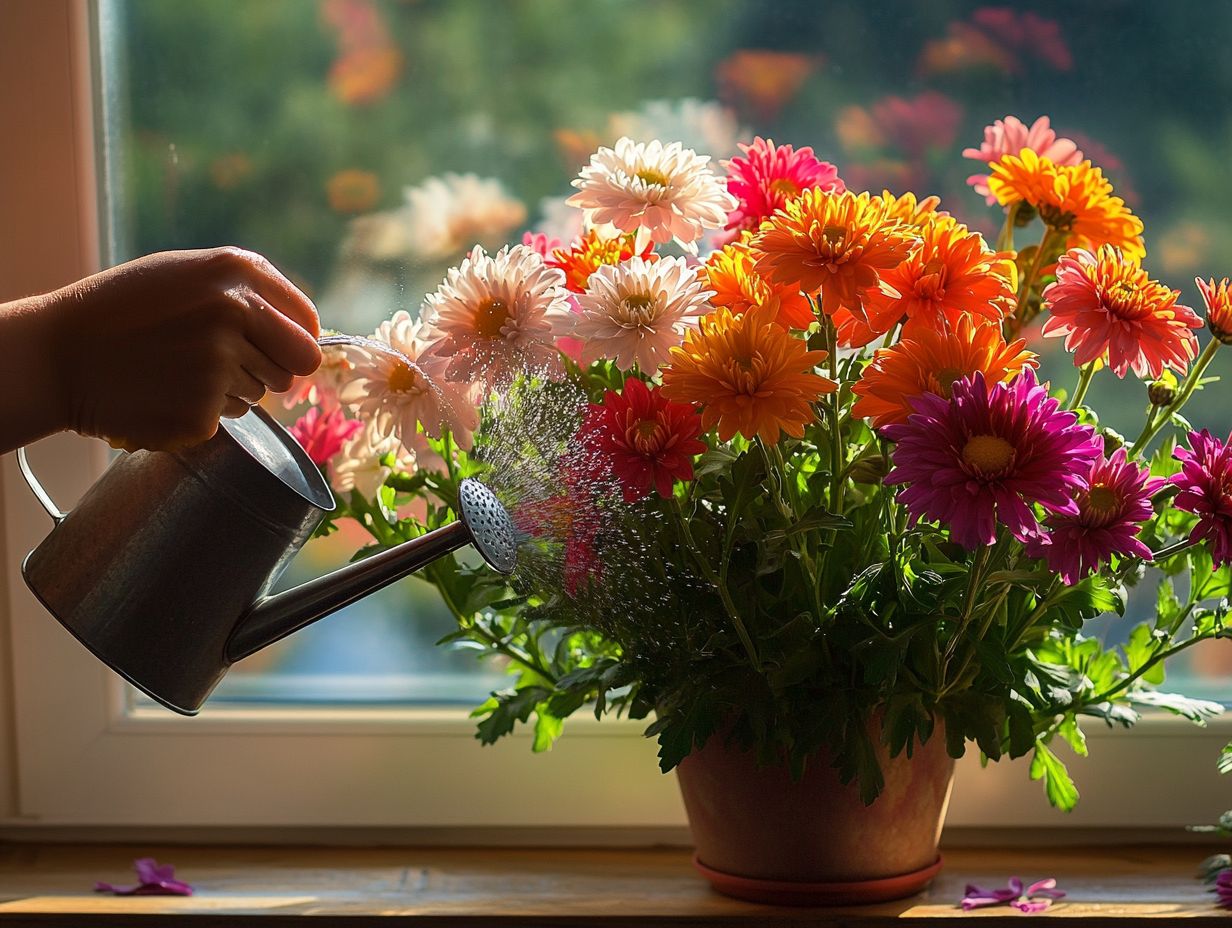
Understanding when and how to repot your indoor chrysanthemums can enhance their growth and health. Watch for signs like roots pushing through the drainage holes, water not absorbing properly, or noticeable stunted growth. These indicate your plant needs more space.
The optimal time for repotting is early spring, just before your plants start their active growth phase. To begin, gently ease the chrysanthemum out of its current pot, being careful not to harm the roots.
Select a pot that is only one size larger and has adequate drainage holes. Use a high-quality potting mix or a blend tailored for flowering plants to provide essential nutrients.
Once your plant is settled in its new home, give it a light watering to settle the soil. Place it in a stable environment to help it adjust smoothly.
Extending the Blooming Season
Extending the blooming season of your indoor chrysanthemums can significantly enhance their flower lifespan. This enriches your indoor environment with vibrant colors.
By employing techniques to prolong their flowering, you can enjoy seasonal blooms for an extended duration. This elevates your indoor gardening experience to new heights of satisfaction.
Tips for Prolonging Flowering
Implementing specific flower care strategies can enhance the longevity of your indoor chrysanthemums. By focusing on seasonal blooms and providing proper nutrition, you can promote flower development.
Consider adjusting the light exposure for your plants. Ensure they receive about six hours of bright, indirect sunlight each day for remarkable results. It’s also essential to optimize your watering schedule. Letting the soil dry slightly between waterings can help prevent root rot and keep your chrysanthemums flourishing.
Don’t underestimate the importance of nutrition. Applying a balanced fertilizer every few weeks will deliver essential nutrients and invigorate your flowers. With these actionable tips, you can create an inviting atmosphere that supports prolonged flowering while boosting the overall health of your plants.
Frequently Asked Questions
How do I care for indoor Chrysanthemums?
To care for indoor Chrysanthemums, place them in a spot with bright, indirect sunlight and water them once a week. Make sure the soil is well-drained and fertilize once a month during the growing season. Keep in mind that Chrysanthemums, often referred to as Mums, thrive best in specific climate zones in the U.S. that suit their growth.
Do Chrysanthemums need a lot of sunlight?
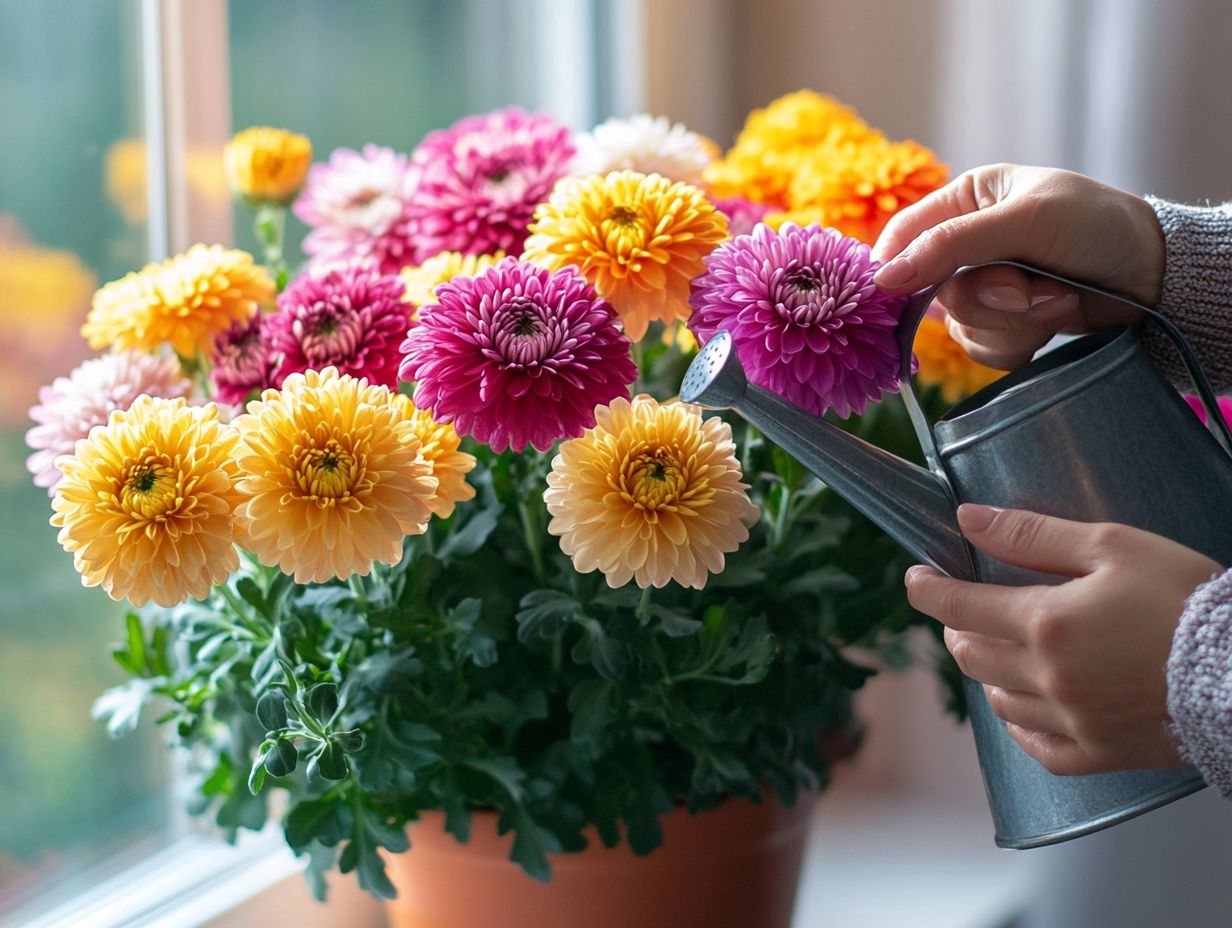
Yes, Chrysanthemums thrive in bright, indirect sunlight. Too little sunlight can result in leggy growth and fewer blooms.
How often should I water my indoor Chrysanthemums?
Water your indoor Chrysanthemums once a week. Make sure the soil is evenly moist but avoid overwatering, as this can cause root rot.
Can I use regular household fertilizer for my Chrysanthemums?
Yes, use a balanced fertilizer that mixes with water. Feed your plants once a month while they are actively growing for the best results.
How do I deadhead my Chrysanthemums?
To deadhead your Chrysanthemums, pinch off the faded flowers and any yellowing or damaged leaves. Doing this will spark new growth and fill your space with even more beautiful blooms!
Do Chrysanthemums need to be pruned?
Regular pruning is essential for maintaining Chrysanthemums’ shape. You can prune them back once a year after they have finished blooming.


